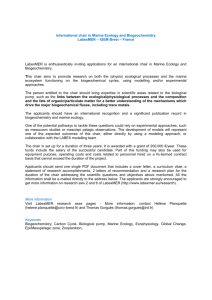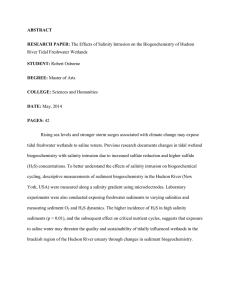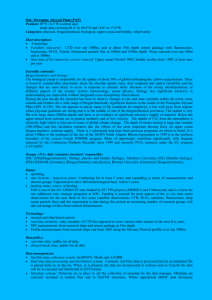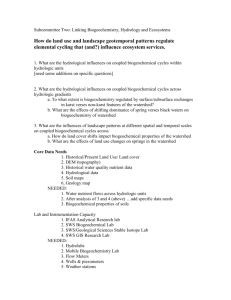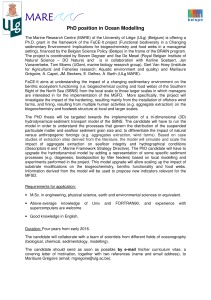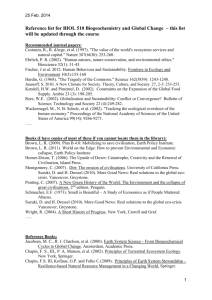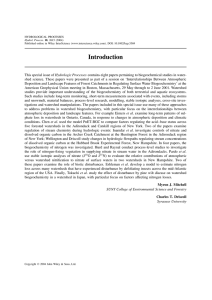T B ERRESTRIAL
advertisement
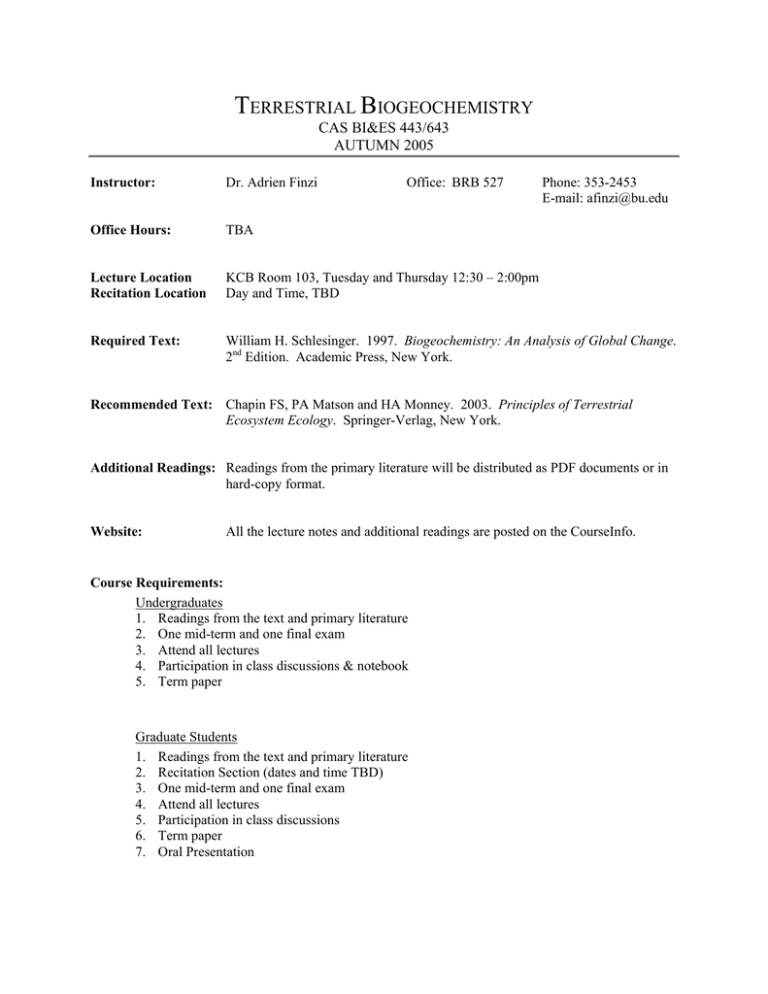
TERRESTRIAL BIOGEOCHEMISTRY CAS BI&ES 443/643 AUTUMN 2005 Instructor: Dr. Adrien Finzi Office: BRB 527 Phone: 353-2453 E-mail: afinzi@bu.edu Office Hours: TBA Lecture Location Recitation Location KCB Room 103, Tuesday and Thursday 12:30 – 2:00pm Day and Time, TBD Required Text: William H. Schlesinger. 1997. Biogeochemistry: An Analysis of Global Change. 2nd Edition. Academic Press, New York. Recommended Text: Chapin FS, PA Matson and HA Monney. 2003. Principles of Terrestrial Ecosystem Ecology. Springer-Verlag, New York. Additional Readings: Readings from the primary literature will be distributed as PDF documents or in hard-copy format. Website: All the lecture notes and additional readings are posted on the CourseInfo. Course Requirements: Undergraduates 1. Readings from the text and primary literature 2. One mid-term and one final exam 3. Attend all lectures 4. Participation in class discussions & notebook 5. Term paper Graduate Students 1. Readings from the text and primary literature 2. Recitation Section (dates and time TBD) 3. One mid-term and one final exam 4. Attend all lectures 5. Participation in class discussions 6. Term paper 7. Oral Presentation Terrestrial Biogeochemistry Course Syllabus Autumn 2005 CAS BI/ES 443/643 Grading: Undergraduates Component Percent of Grade Exam I 25% Final Exam 25% Class Participation + Notebooks 25% Term Paper 25% TOTAL 100% Points 125 125 125 125 500 Graduate Students Component Percent of Grade Exam I 19% Final Exam 19% Class Participation + Notebooks 19% Term Paper 19% Presentation 9% Recitation 15% TOTAL 100% Points 125 125 125 125 60 100 660 Important Dates: Last day to drop without a W grade is Friday October 7. Last day to drop with a W is Friday, October 28. Objectives The objective of this course is to introduce you to the concepts and important topics in terrestrial biogeochemistry. We will begin with an analysis of where, when and how energy and elements arrived on plant earth. We will consider the comparative biogeochemistry of neighboring planets in our analysis. From here we will consider the basic metabolic pathways of early life on earth and their effect on the atmosphere and lithosphere. We will then consider the basic mechanisms underlying the biogeochemical transformation of carbon, nitrogen, phosphorus and other rock-derived elements. This analysis will include a consideration of plot-level, regional and global scales. We will, when appropriate, consider the biogeochemistry of aquatic and marine ecosystems. This course will also consider the effect of human activity on biogeochemical cycles. The foundations for the course are lectures, readings from the text, readings from the scientific literature, and discussions. In order to do well in this course, you must have completed a year in inorganic chemistry (CH101, CH102) and introductory biology (BI107) or introductory earth sciences (ES101 or ES 105). Lectures Lectures are considered to be the core of the course. They are designed to introduce the important concepts in ecology, and help clarify information presented in the text and supplementary readings. Lectures will be illustrated with overheads and handouts, and occasionally slides and videos. A large fraction of the information presented is only available in lectures. Failure to attend lectures will seriously compromise opportunities for gaining the full benefits of this course. Lecture Absence Policy: Only two unexcused absences will be allowed without penalty. For each unexcused absence thereafter, your grade will automatically drop one-half grade for each absence (A to A-, A- to B+, B+ to B, etc.). Terrestrial Biogeochemistry Course Syllabus Autumn 2005 CAS BI/ES 443/643 Discussions (All students) Reading from the primary literature and in-class discussions are a critical component of this course. We will have in-class discussions seven times throughout the semester. Both undergraduate and graduate students will participate in the in-class discussion. The readings will focus on the state-of-the-science for a given topic and the implications of anthropogenic change. It is critical to read all papers—more than once if necessary—and come prepared to discuss your comments and questions. Discussions are meant to be fun rather than a chore, so come with an open mind and a willingness to work hard, to ask questions, and offer an opinion! Written Log: You must keep a hand-written log of the answers to each of the following questions in a notebook for every paper that you read. You will hand in this notebook at the end of the semester. The written log is worth 25 points or 5% of your overall grade. You will be evaluated for the consistency and depth with which each of the five questions is answered. For each reading answer the following questions: 1. What is the question being addressed? 2. Why is this research question important? 3. What methods are used to answer this question? 4. What are the papers major findings, conclusions, and implications? 5. Are the methods adequate to answer the question? If so, why? If not, why not? Discussion Leaders: Each student will be a discussion “leader” during the semester. Given the current enrollment, there will be two discussion leaders per in-class discussion. Each discussion leader is responsible for synthesizing Points 1 – 5 for each paper. You can use overheads or other visual aids to summarize the papers but you must limit your review to no more than 5-10 minutes per paper. The discussion leader will then be responsible for leading a discussion. Grading for Undergraduate, In-Class Discussion: You will be graded on the following criteria: 1. 2. 3. 4. Overall Preparedness and Regularity of Participation Ability to communicate effectively Ability to Synthesize Information and Generate Points for Discussion Ability to lead a discussion 25 Points 25 Points 25 Points 25 Points Recitation (Graduate Students Only) Graduate students will participate in a separate 2 hour recitation section for this course. For each recitation section you be required to read two additional papers on a topic covered in the most recent “inclass” discussion. There will therefore be a total of 7 recitation sections throughout the semester, in the week following the “in-class” discussion. The recitation section is intended to introduce you to the primary literature at a greater depth than is covered in class. Each graduate student will be responsible for synthesizing the results of their paper. We will then open the recitation to a general discussion of all recently read materials. Term Paper The term paper will be based on a topic of your choice. The term paper will require a minimum of 25 peer-reviewed publications from the primary science literature. You cannot draw information from the world-wide web. Peer-review is a cornerstone of scientific integrity and excellence. Without peer- Terrestrial Biogeochemistry Course Syllabus Autumn 2005 CAS BI/ES 443/643 review, there is no way to be sure that the information you obtain has any validity. You are required to hand in a term-paper topic and a list of 10 references by Thursday November 10, 2005. The completed term paper is due on Thursday December 8 2005. Due Date Policy: Due dates are absolute! Five points will be deducted for each day that the term paper is handed in late. After one week the paper will not be accepted. The term paper must be typed in 12-point Times or Times New Roman font, it must be double spaced, and it cannot exceed 10 pages. Independence of Work The coursework should reflect your own contribution. You should feel free to study together, discuss papers in advance of class and discuss the findings of your term paper. You cannot, however, exchange information with one another on exams, nor can you write a classmates term paper or any section thereof. Studying for Exams When studying for exams, you should rely equally on lecture material, relevant sections in your textbook and the supplemental readings. Questions on the in-class and final exams will be drawn from these sources. The final exam will be given after classes during the final-examination period. Examination Policy: No make-up exams will be given without extensive documentation that the absence was unavoidable. In such a case, the day and time of the examination will be scheduled on a case-bycase basis. Academic Conduct For your convenience I have reprinted the CAS Code of Academic Conduct as it appears in the Undergraduate and Graduate Bulletin. You must adhere to this academic code. Departures from this code will have serious repercussions (see below). “For College of Arts and Sciences students, charges of academic misconduct, such as cheating on examinations, theft of examinations, plagiarism, alteration of work after submission, or alteration of records, are referred to as the College of Arts and Sciences Academic Conduct Committee. Students are advised that, by vote of the College faculty, the penalty against College of Arts and Sciences students for cheating on examinations or plagiarism may be expulsion from the University or such other penalty as may be recommended by the committee on Student Academic Conduct, subject to approval by the Dean. All students are responsible for having read the College of Arts and Sciences statement on plagiarism, which is available in the Academic Conduct Code. In all charges of academic misconduct against a student, the student is entitled to full procedural fairness in any disciplinary proceedings that may be conducted. A description of the procedures adopted by the Committee on Student Academic Conduct appears in the Academic Conduct Code, available from CAS Room 105.” Terrestrial Biogeochemistry DATE September Course Syllabus Autumn 2005 CAS BI/ES 443/643 TOPIC AND READING ASSIGNMENTS 6 Course Guidelines, Overview, Chapter 1 Biogeochemistry 8 Origins of Elements, Chapter 2 Biogeochemistry 13 Origins of the Elements, Chapter 2 Biogeochemistry 15 The Atmosphere, Chapter 3 Biogeochemistry 20 Readings I: Climate and the Global Water Cycle Levitus et al. (2001). Anthropogenic warming of earth’s climate system. Science 292:267-270 Lambeck et al. (2002). Links between climate and sea levels for the past three million years. Nature 419: 199 – 206. Jackson et al. (2001). Water in a changing world. Ecological Applications 11:1027 - 1045 22 The Lithosphere, Chapter 4 Biogeochemistry 27 The Lithosphere 29 Readings II: Soil Weathering, Nutrient Supply and Nutrient Loss Chadwick O.A., et al. (1999). Changing sources of nutrients during four million years of ecosystem development. Nature 397:491-497. Markewitz D. et al. (2001). Control of cation concentrations in streams by surface soil processes in an Amazonian watershed. Nature 410:802-805. Hedin L.O. et al. (2003). Nutrient losses over four million years of tropical forest development. Ecology 84:2231-2255. Likens Acid Rain reading??? October 4 Carbon Cycle of Terrestrial Ecosystems, Chapter 5 Biogeochemistry 6 Carbon Cycle of Terrestrial Ecosystems, Chapter 5 Biogeochemistry 11 Carbon Cycle of Terrestrial Ecosystems, Chapter 5 Biogeochemistry 13 Carbon Cycle of Terrestrial Ecosystems, Chapter 5 Biogeochemistry 18 Readings III: Soil Carbon Cycling and Primary Production Goulden M.L. et al. (1998). Sensitivity of boreal forest carbon balance to soil thaw. Science 279:214-217. Knapp et al. (2002). Rainfall variability, carbon cycling, and plant species diversity in a mesic grassland. Science 298:2202-2205. Schurr E.G. et a. (2001). Carbon cycling and soil carbon storage in mesic to wet Hawaiian montane forests. Ecology 82:3182-3196. 20 Global Carbon Cycle, Chapter 11 Biogeochemistry Terrestrial Biogeochemistry DATE October Course Syllabus Autumn 2005 CAS BI/ES 443/643 TOPIC AND READING ASSIGNMENTS 25 Exam I 27 Global Carbon Cycle, Chapter 11 Biogeochemistry November 1 3 Global Carbon Cycle, Chapter 11 Readings IV: The Global Carbon Cycle: What Have We Done? Schimel J.S. et al. (2001). Recent patterns and mechanisms of carbon exchange by terrestrial ecosystems. Nature 414:169-172. House J.I. et al. (2002). Maximum impacts of future reforestation or deforestation on atmospheric CO2. Global Change Biology 8:1047-1052. Falkowski et al. (2002). The global carbon cycle: a test of our knowledge of Earth as a system. Science 290:291-296. 8 Global Carbon Cycle, Chapter 11 10 Biogeochemical Cycling on Land, Chapter 6 15 Biogeochemical Cycling on Land, Chapter 6 17 Biogeochemical Cycling on Land, Chapter 6 22 Readings V: Inputs, Losses and Excess N Vitousek P.M. et al. (1991). Nitrogen limitation on the land and in the sea: how can it occur? Biogeochemistry 13:87-115. Perakis SS et al. (2002). Nitrogen losses from unpolluted South American forests primarily via dissolved organic compounds. Nature 416-420. Peterjohn W.T. et al. (1996). Symptoms of nitrogen saturation in two central hardwood forest ecosystems. Biogeochemistry 35:507-522. December 24 Thanksgiving Break 29 Global N Cycle, Chapter 12 Biogeochemistry 1 Readings VI: Components of the Global N Cycle Vitousek P.M. et al. (1997). Human alteration of the global nitrogen cycle: sources and consequences. Ecological Applications 7:737-750. Amundson R. et al. (2003). Global patterns of the isotopic composition of soil and plant nitrogen. Global Biogeochemical Cycles 17:1031. Walvoord M.A. et al. (2003). A reservoir of nitrate beneath desert soils. Science 302:1021-1024. 6 Global N Cycle, Chapter 12 Biogeochemistry 8 Final Exam
